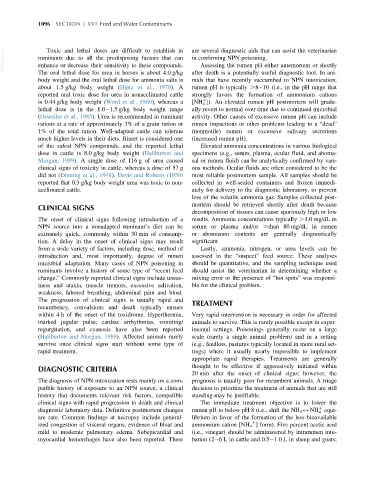Page 1164 - Veterinary Toxicology, Basic and Clinical Principles, 3rd Edition
P. 1164
1096 SECTION | XVI Feed and Water Contaminants
VetBooks.ir ruminants due to all the predisposing factors that can are several diagnostic aids that can assist the veterinarian
Toxic and lethal doses are difficult to establish in
in confirming NPN poisoning.
Assessing the rumen pH either antemortem or shortly
enhance or decrease their sensitivity to these compounds.
The oral lethal dose for urea in horses is about 4.0 g/kg after death is a potentially useful diagnostic tool. In ani-
body weight and the oral lethal dose for ammonia salts is mals that have recently succumbed to NPN intoxication,
about 1.5 g/kg body weight (Hintz et al., 1970). A rumen pH is typically .8 10 (i.e., in the pH range that
reported oral toxic dose for urea in nonacclimated cattle strongly favors the formation of ammonium cations
1
is 0.44 g/kg body weight (Word et al., 1960), whereas a [NH ]). An elevated rumen pH postmortem will gradu-
4
lethal dose is in the 1.0 1.5 g/kg body weight range ally revert to normal over time due to continued microbial
(Osweiler et al., 1985). Urea is recommended in ruminant activity. Other causes of excessive rumen pH can include
rations at a rate of approximately 3% of a grain ration or rumen impactions or other problems leading to a “dead”
1% of the total ration. Well-adapted cattle can tolerate (nonmotile) rumen or excessive salivary secretions
much higher levels in their diets. Biuret is considered one (increased rumen pH).
of the safest NPN compounds, and the reported lethal Elevated ammonia concentrations in various biological
dose in cattle is 8.0 g/kg body weight (Haliburton and specimens (e.g., serum, plasma, ocular fluid, and aboma-
Morgan, 1989). A single dose of 116 g of urea caused sal or rumen fluid) can be analytically confirmed by vari-
clinical signs of toxicity in cattle, whereas a dose of 57 g ous methods. Ocular fluids are often considered to be the
did not (Dinning et al., 1948). Davis and Roberts (1959) most reliable postmortem sample. All samples should be
reported that 0.3 g/kg body weight urea was toxic to non- collected in well-sealed containers and frozen immedi-
acclimated cattle. ately for delivery to the diagnostic laboratory, to prevent
loss of the volatile ammonia gas. Samples collected post-
mortem should be retrieved shortly after death because
CLINICAL SIGNS
decomposition of tissues can cause spuriously high or low
The onset of clinical signs following introduction of a results. Ammonia concentrations typically .1.0 mg/dL in
NPN source into a nonadapted ruminant’s diet can be serum or plasma and/or .than 80 mg/dL in rumen
extremely quick, commonly within 30 min of consump- or abomasum contents are generally diagnostically
tion. A delay in the onset of clinical signs may result significant.
from a wide variety of factors, including dose, method of Lastly, ammonia, nitrogen, or urea levels can be
introduction and, most importantly, degree of rumen assessed in the “suspect” feed source. These analyses
microbial adaptation. Many cases of NPN poisoning in should be quantitative, and the sampling technique used
ruminants involve a history of some type of “recent feed should assist the veterinarian in determining whether a
change.” Commonly reported clinical signs include uneas- mixing error or the presence of “hot spots” was responsi-
iness and ataxia, muscle tremors, excessive salivation, ble for the clinical problem.
weakness, labored breathing, abdominal pain and bloat.
The progression of clinical signs is usually rapid and TREATMENT
recumbency, convulsions and death typically ensues
within 4 h of the onset of the toxidrome. Hyperthermia, Very rapid intervention is necessary in order for affected
marked jugular pulse, cardiac arrhythmias, vomiting/ animals to survive. This is rarely possible except in exper-
regurgitation, and cyanosis have also been reported imental settings. Poisonings generally occur on a large
(Haliburton and Morgan, 1989). Affected animals rarely scale (rarely a single animal problem) and in a setting
survive once clinical signs start without some type of (e.g., feedlots, pastures typically located in more rural set-
rapid treatment. tings) where it usually nearly impossible to implement
appropriate rapid therapies. Treatments are generally
thought to be effective if aggressively initiated within
DIAGNOSTIC CRITERIA
20 min after the onset of clinical signs; however, the
The diagnosis of NPN intoxication rests mainly on a com- prognosis is usually poor for recumbent animals. A triage
patible history of exposure to an NPN source, a clinical decision to prioritize the treatment of animals that are still
history that documents relevant risk factors, compatible standing may be justifiable.
clinical signs with rapid progression to death and clinical The immediate treatment objective is to lower the
1
diagnostic laboratory data. Definitive postmortem changes rumen pH to below pH 8 (i.e., shift the NH 3 2NH equi-
4
are rare. Common findings at necropsy include general- librium in favor of the formation of the less bioavailable
1
ized congestion of visceral organs, evidence of bloat and ammonium cation [NH 4 ] form). Five percent acetic acid
mild to moderate pulmonary edema. Subepicardial and (i.e., vinegar) should be administered by intrarumen intu-
myocardial hemorrhages have also been reported. There bation (2 6 L in cattle and 0.5 1.0 L in sheep and goats;

